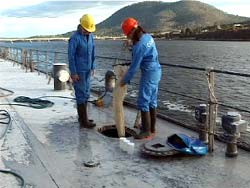

CSIRO marine scientists have developed a technique that gives new hope in the battle to stop the spread of aquatic pests
“What we have is a probe acting as a magnet to detect a needle in a haystack,” says Dr Jawahar Patil, who designed the technique which has been successfully tested in Australia.
The new DNA probe involves seawater sample extraction of DNA, and amplification of a target specific “DNA signature or fingerprint” to identify the presence of pest species in water.
This means that aquatic pests in ballast water can now be confirmed without costly screening and can be uniquely identified at the larval and juvenile stages, a process welcomed by shipowners.
“The test is a world-first in this field of research that we would not have dreamed possible a decade ago,” said Teresa Hatch, Manager of Operations, Ship Safety at the Australian Shipowners Association.
“It will save the shipping industry money in the long-run and give Australia’s coastal environment a new level of protection,” said Ms Hatch.
A senior marine ecologist at CSIRO, Dr Nic Bax, said the technique provided another level of understanding of the risks of marine invasions as well as greater protection against species which posed a risk to human health or could alter the balance of nature in the marine environment.
The species-specific probes have been developed for three high-priority species in Australia’s south-east:
- The Northern Pacific seastar (Asterias amurensis)
- The Pacific oyster (Crassostrea gigas)
- The toxic dinoflagellate (Gymnodinium catenatum)
“Looking for larval pests in water samples is like looking for a needle in a hay stack and the probes give us a new set of eyes for the marine environment,” said Dr Jawahar Patil, who led the research team, including Dr Bax, Mr Bruce Deagle and Dr Rasanthi Gunasekera, all from CSIRO.
Development of the probes has been undertaken in partnership with shipping and port industries and the Australian Quarantine and Inspection Service. It has been funded by the Commonwealth Government’s Natural Heritage Trust and the Victorian Government as part of the Port of Hastings National trial of ballast water management.
For more information:
Media assistance: CSIRO Marine Division Craig Macaulay 03 6232 5219 or 0419 966 465
Dr Nic Bax, CSIRO, 03-62325341 (available after 10.30am EST)
Teresa Hatch, Australian Shipowners Association 03 9646 0755
Coast to Coast 04 conference media contact: Jess Tyler, 0408 298 292














